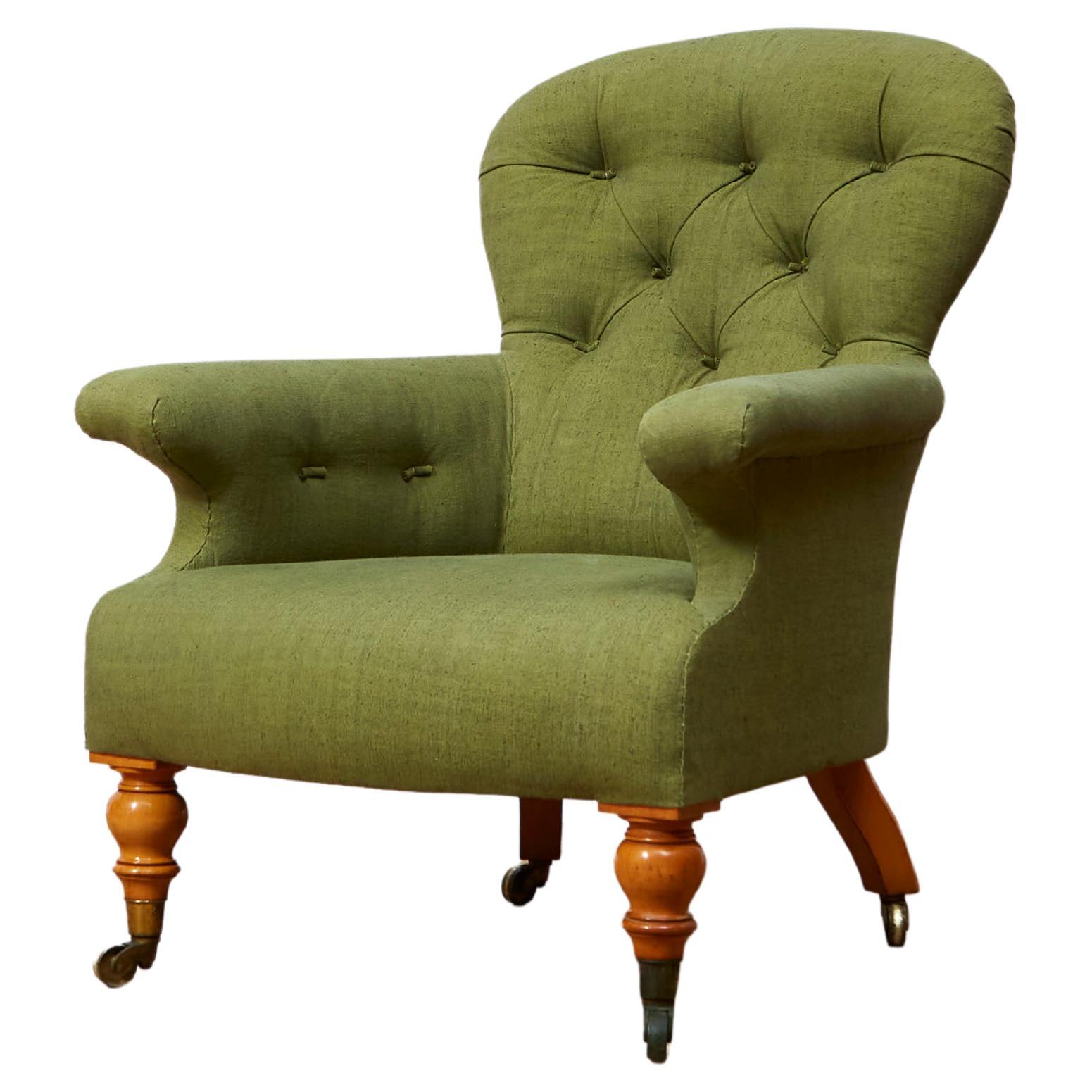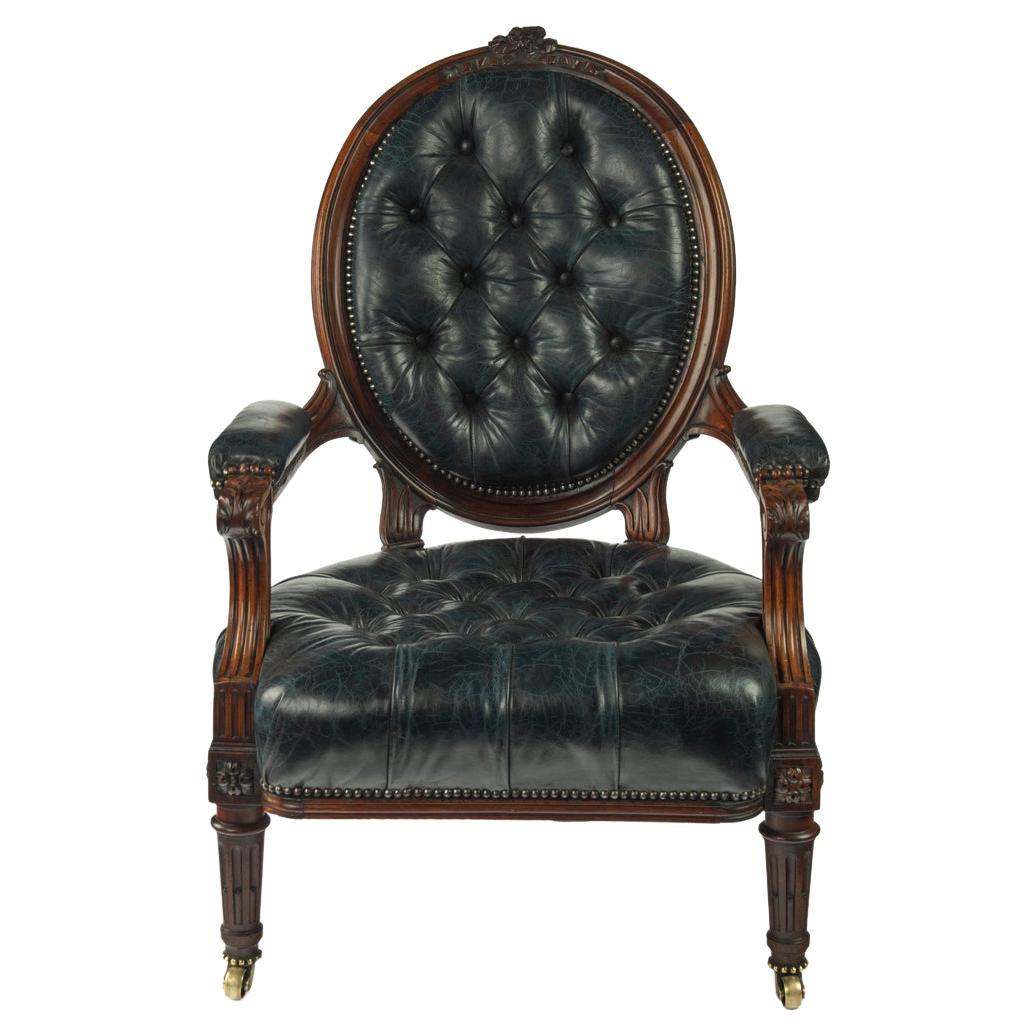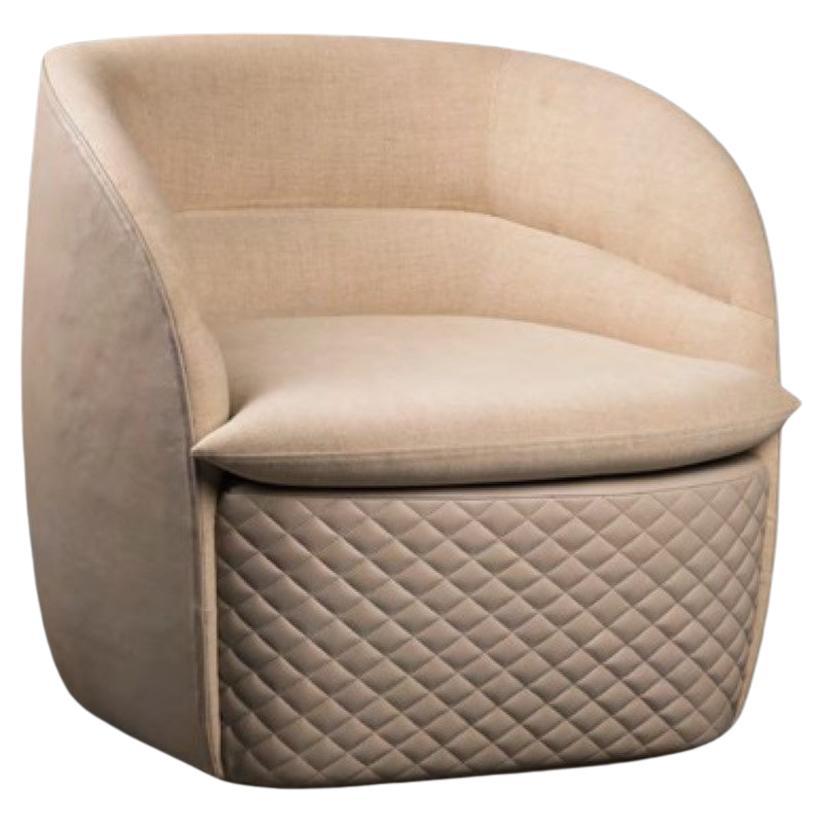Items Similar to Open Armchair by Hindley & Son. upholstered in vintage Kente Cloth
Want more images or videos?
Request additional images or videos from the seller
1 of 5
Open Armchair by Hindley & Son. upholstered in vintage Kente Cloth
About the Item
Mid-19th Century open armchair by Hindley & Son made in birch and upholstered in a vintage blue and white Kente Cloth from Ghana. Mid-19th Century.
Fully restored and re-upholstered.
- Creator:Charles Hindley & Sons (Manufacturer)
- Dimensions:Height: 35.44 in (90 cm)Width: 25.2 in (64 cm)Depth: 32.29 in (82 cm)
- Style:Late Victorian (Of the Period)
- Materials and Techniques:
- Period:
- Date of Manufacture:Mid-19th Century
- Condition:Reupholstered.
- Seller Location:London, GB
- Reference Number:
About the Seller
No Reviews Yet
Vetted Seller
These experienced sellers undergo a comprehensive evaluation by our team of in-house experts.
1stDibs seller since 2022
27 sales on 1stDibs
Typical response time: 4 hours
- ShippingRetrieving quote...Ships From: London, United Kingdom
- Return PolicyA return for this item may be initiated within 14 days of delivery.
More From This SellerView All
- Large Victorian Open Armchair by Maple and Co.By Maple & Co.Located in London, GBLarge Victorian Open Armchair by Maple & Co. A large Victorian upholstered open armchair, stamped 'Maple & Co' Stripped to original upholster...Category
Antique Mid-19th Century Victorian Armchairs
MaterialsUpholstery, Walnut
- Victorian Walnut ArmchairBy Maple & Co.Located in London, GBVictorian walnut armchair A Victorian walnut armchair of good proportions. Fully restored and covered in calico. Loose cover made in 'Old Flax, Ivory' by ...Category
Antique 19th Century Victorian Armchairs
MaterialsWalnut
- English Armchair, circa 1910Located in London, GBEnglish armchair, circa 1910 An English library armchair c.1910. Tapered legs on original brass castors, supporting a fine padded back, arm...Category
20th Century English Armchairs
MaterialsBrass
- Easy Chair in Sissoo by Pierre Jeanneret c.1955By Pierre JeanneretLocated in London, GBWonderful original Easy Chair designed by Pierre Jeanneret. Model no. PJ-SI-29-A. The Easy Chair is masterpiece of modernist design, comfortable and practical, showcasing Jeanneret’s iconic “compass” style, with triangular-section legs, curved backrest and sloping armrests. Made in richly coloured Sissoo, lightly restored and re-caned to retain as much of the chair’s original patina as possible. Pierre Jeanneret (22 March 1896 - 4 December 1967) was a Swiss architect who collaborated with his cousin, Le Corbusier, designing furniture for Le Corbusier's vast modernist complex at Chandigarh. Jeanneret remained for over 15 years as the project’s chief architect and the city remains a masterpiece of the modern vision. The pair pioneered a new aesthetic that placed function and order over embellishment—Jeanneret’s work imbuing the strict geometry of modernism with lighter materials like cane and wood. Jeanneret also collaborated with other modern masters, Charlotte Perriand on experiments in aluminium and wood, and Jean Prouve developing prefabricated housing. Literature: Catalogue Raisonné du Mobilier: Jeanneret Chandigarh, 2019. Le Corbusier, Pierre Jeanneret, The Indian Adventure...Category
Mid-20th Century Indian Mid-Century Modern Armchairs
MaterialsTeak
- Easy Chair in Sissoo by Pierre Jeanneret, circa 1955By Pierre JeanneretLocated in London, GBWonderful original Easy Chair designed by Pierre Jeanneret. Model no. PJ-SI-29-A. The Easy Chair is masterpiece of modernist design, comfortable and practical, showcasing Jeanneret’s...Category
Mid-20th Century Indian Mid-Century Modern Armchairs
MaterialsCane, Teak
- English Ladder Back Armchair, Early 19th CenturyLocated in London, GBEnglish Ladder back armchair, Early 19th Century A country-made early 19th century ladder back armchair. Made in Ash with great patina and origi...Category
Antique Early 19th Century English Folk Art Armchairs
MaterialsAsh
You May Also Like
- Mid-19th Hindley & Sons Country House ArmchairBy Charles Hindley & SonsLocated in London, GBAn elegant Hindley & Sons upholstered armchair with satinwood legs, newly covered using naturally dyed antique linen in bottle green. English, early nineteenth century.Category
Antique Mid-19th Century British Victorian Lounge Chairs
MaterialsLinen, Satinwood
- Victorian Rosewood Medallion Backed Open Armchair by Holland & SonsLocated in Lymington, HampshireA Victorian rosewood medallion backed open arm chair by Holland & Sons, the rounded back and seat raised upon stop fluted front legs and kicked out ...Category
Antique 1860s English Victorian Armchairs
MaterialsLeather, Rosewood
- circa 1845 C Hindley & Sons Lion Carved Chesterfield Brown Leather Dining ChairsBy Chesterfield, Charles Hindley & SonsLocated in GBWe are delighted to offer this very rare and important suite of five fully restored C Hindley & Son’s dining chairs circa 1844-1845 These are a very important and substantial set of chairs, they have been fully restored to include being stripped back to the bare frames, all the timber has been washed back and French polished , they have then been resprung using the original period coil sprung bases, new webbing fitted, then upholstered with premium Italian cattle grade fully aniline plain natural leather which has been individually hand nail tacked in place using antiqued studs, lastly hand dyed six times and antiqued to give it this one off cigar brown colour. These chairs have been on a journey as mentioned and they are true investment pieces, ready to serve the new owner for decades to come. Usually, I wouldn’t take dining chairs through such an expensive process however the carving to the legs is so sublime they warranted the treatment, I have never seen such beautiful Lion’s mains and terminating with hairy paws with recessed castors, these are simply put the finest dining chairs on the market anywhere in the world today you can buy. Dimensions Height:- 94.5cm Width:- 57cm Depth:- 74cm Seat height:- 50cm ABOUT THE CABINET MAKERS Hindley, Charles & Sons Berners Street & Oxford Street, London; cabinet makers, upholsterers and retailers (fl.c.1820-1892) Charles Hugh Hindley (b.1792- d.1871) was the son of Christopher, a merchant in Mere, Wiltshire. He moved to London with an elder brother to live with his uncle, who was possibly running the London branch of the Wiltshire business. In 1817 Charles joined the upholstery firm of Benjamin Merriman Nias at 32 Berners Street. Within a few years he bought the Nias business with a £1,000 investment from his family. Despite his business being described as a 'carpet warehouse' in London directories from 1820-1841, by the mid-1830s upholstery and cabinet work had joined his repertoire and he had taken on more showroom space next door at 31 Berners Street. Family records of the 1840s showed that individual custom-order business expanded to also ‘supplying established furnishing houses with goods on wholesale terms’. Jobs ranged from supplying Pentonville Prison with 100 hair mattresses and pillows, to altering spring roller blinds, to fulfilling private commissions with suites of parlour furniture. Hindley was the father of eleven children with three involved in the business: Charles Hugh (b. 1818), Frederick (b. 1820), and Albert Daniel (b.1822). Charles Hugh and Frederick joined the family firm about 1832, thus establishing the family partnership, Charles Hindley & Sons. Albert Daniel learned the carpet manufactory and trade in Kidderminster and eventually established a carpet manufactory in Liversedge, Yorkshire, supplying the family’s London store and others. In 1845 he patented an early tufted carpeting technique. Charles Hindley & Sons acquired the firm, Miles & Edwards in September 1844, including their premises at 134 Oxford Street. Both companies operated from this address until 1845 when Miles & Edwards was closed. The purchase of Miles & Edwards enabled Hindley & Co. to compete with other West End firms by offering everything from cabinet making and upholstery to painted decoration and interior design for the middle and upper class market. In a sample of 737 orders from October 1842-June 1845, six per cent of the clientele were upper and lower aristocracy with approximately seventy per cent gentry or middle class. The aristocratic clientele included the surnames of Hoare, Kirland, Drummond, Montefiore, Ashburton and Rothschild, and the Oriental Club at 18 Hanover Square (1824). Commissions were also executed for: Lady Fetherstonaugh at Uppark: bills dating 1852 and 1862 for furniture and curtains C B E Wright of Bolton Hall, Yorkshire: decorative wood panels The Earl of Dudley at Himley Hall, Staffordshire: a carved gilt wood centre table with mosaic top, dated 1845 and a bedroom suite (sold by Hampton & Sons, July 1924) Sir Clifford Constable at Burton Constable (1849) George Hammond Lucy at Charlecote Park: carpeting (19 December 1844) The Duke of Cleveland at Raby Castle The Duke of Argyll, the Duke of Newcastle Lord and Lady Burton of Burton-on-Trent Sir William Eden of Windlestone Hall, Durham. Buckingham Palace: a small supply of Chintz wall covering for some rooms (1855) Surviving marked furniture by Hindley & Co. includes a stamped Regency kidney-shaped desk, veneered in yew and panelled with boxwood and ebony inlay, ornamented with finely-chased mounts and beadings, c.1830 [Connoiseur, November 1978], which is possibly the one illustrated in Gilbert (1996), fig. 498, and a walnut writing table with a raised set of drawers, 1840s, stamped C. Hindley & Sons, illus. (Gilbert (1996), fig. 497 and sold by Sotheby’s, 5 August 1981, lot 209. The staff at 134 Oxford Street comprised management, sales staff, designers, foreman, clerks, cabinet makers, chair makers, upholsterers, carvers, carpenters and French polishers. They also contracted tradesmen specialising in particular decorative and finishing techniques; such as Joseph Spong, a japanner, and William Stannard, a carver and gilder, who supplied significant orders, 1845-46. Stannard was also recorded in the stock book for ‘Repairing, Cleaning and Varnishing 18 Paintings [frames] £9.0.0’. Family records describe several employees: ‘a large and very ancient carpenter named Tomlinson… a cabinetmaker named Westbrook... [and] a foreman named Sorrel’. Charles Hindley & Sons showed a large Gothic sideboard at the Great Exhibition in 1851, inspired by Pugin (illustrated Microulis, Studies in the Decorative Arts (Spring/Summer 1998) p. 86) and they exhibited a Gothic bookcase and large sideboard at the 1862 International Exhibition, London (illustrated Microulis, Studies in the Decorative Arts (Spring/Summer 1998) p. 88). Both were elaborately carved pieces, described in the Art Journal Illustrated Catalogue as ‘evidence of sound judgment and advanced taste in the designer, and of able and skilful workmanship’. They also participated in the Building Trades Exhibition at the Agricultural Hall, Islington, 1883 [The Furniture Gazette, 7 April 1883]. They exhibited Japanese leather papers at the Manchester Fine Art & Industrial Exhibition, 1882, and were awarded a silver medal for embossed leather wall hangings at the Calcutta International Exhibition, 1883 [The Furniture Gazette, 18 November 1882 & 10 May 10 May 1884]. They also participated in the Workman’s Exhibition at Central Hall in Holborn, 1890 [The Furniture Gazette, 15 April 1890]. The designers did not sign their work but about fifteen different people were probably involved during the fifty-year period. One designer who worked in the late 1880s was J. Armstrong Stenhouse. He and the cabinet makers, G. R. Mackenzie, D. MacLennan and D. F. Lavach, as well as the carver, F. Lucas, worked on two Hindley exhibition pieces for the 2nd exhibition of the Arts and Crafts Society, London An archive of 114 drawings (now at the Metropolitan Museum of Art) was collated by Charles Albert Hindley (1863-1947), a grandson of the founder. These designs c.1844-1883 (some illustrated in ?Microulis, Furniture History?(2001), figs 1-16.), reflected the current trends of reinterpreted styles such as Gothic and Louis, and several seated furniture designs were labelled with specific commercial names such as the ‘Victoria Chair...Category
Antique 1840s English Early Victorian Dining Room Chairs
MaterialsLeather, Hardwood
- Twelve Set Chairs Armchairs Open Fruitwood Upholstered Dining Renaissance-StyleLocated in BUNGAY, SUFFOLKA rare long set of 12, Antiquarian, Renaissance-style, Fruitwood, Upholstered, Open Armchairs - Rare to find a set of 12 of a Renaissance-style armchair, in 35 years of dealing I ...Category
Vintage 1920s French Renaissance Chairs
MaterialsFruitwood
- Upholstered Annis Armchair by MadhekeLocated in Geneve, CHUpholstered Annis Armchair by Madheke Dimensions: W 85 x D 89 x H 82 cm Materials: Leather, Fabric Quilted front, upholstered back and outer. Reflecting the finest in craftsmanship, innovation and heritage, Madheke creates tailored and crafted goods that reflect understated classic elegance, blending tradition and contemporary - vintage and modern...Category
2010s Indian Modern Armchairs
MaterialsLeather, Fabric
- Sam Son Armchair in Red by Konstantin Grcic for MAGISBy Magis, Konstantin HableLocated in Brooklyn, NYSam Son is an easy armchair with a hint of a cartoon character. Supported on four stilt legs, the armchair features a softly suspended seat shell between a giant, horseshoe-shaped el...Category
21st Century and Contemporary Italian Chairs
MaterialsPlastic
Recently Viewed
View AllMore Ways To Browse
Hindley And Sons
Yves Gastou
Altay Armchair
Digamma Lounge Chair 1957
Karhula Glass
Laid Back Wooden Chair
Le Manach
Pair Of Ercol Chairs
Pk11 Armchair By Poul Kjaerholm
Vintage Mid Century Parker Knoll Armchair
Vintage Parker Knoll Armchair
Vintage Parker Knoll Armchairs
Diplomat Chair Rosewood
Driade Toy
Gispen 412
Gp J Baker
Pair Of Chippendale Gainsborough Armchairs
Shadow Meritalia





